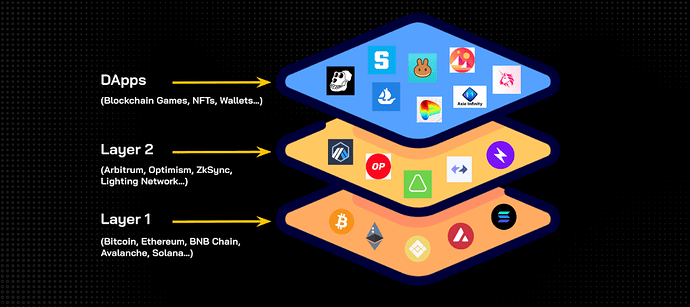Blockchain Layer 1 serves as the foundational level of a blockchain network, but its ability to scale is constrained.
Presently, blockchain stands out as a technology widely employed as the basis for crafting highly efficient business solutions and applications worldwide, characterized by a rapid surge in transaction execution speed. Blockchain offers three core advantages: Decentralization, Security, and Scalability.
Yet, according to Vitalik Buterin, the mind behind Ethereum, he asserts that blockchain technology can only ensure two properties simultaneously. Consequently, scalability may face challenges when it comes to meeting the dynamic demands for transaction execution and user data security.
Enhancing scalability emerges as a significant hurdle for Blockchain Layer 1. In response, solutions for expanding Blockchain Layer 1 have been proposed to uphold processing speed and transaction volume on the platform.
So, what exactly is Blockchain Layer 1?
Blockchain Layer 1 constitutes the foundational stratum of a blockchain network, providing the groundwork for developing decentralized applications (dApps) and addressing and validating transactions for smart contracts, dApps, and other blockchain layers.
Another pivotal aspect of Blockchain Layer 1 is its independence from any other network.
Additionally, Blockchain Layer 1 networks shoulder the responsibility for the security and consensus of dApps and Layer 2 blockchain solutions developed on the network. Developers can leverage Blockchain Layer 1 networks to fashion diverse protocols on them without the necessity of creating an entirely new blockchain or distinct native tokens.
Comprehending the solution for expanding Blockchain Layer 1:
The solution for expanding Blockchain Layer 1 essentially refers to a suite of solutions deployed to refine the design of underlying protocols, thereby facilitating improved scalability for the entire system.
Classification of solutions for expanding Blockchain Layer 1:
- Novel consensus protocols: Transitioning from Proof-of-Work to Proof-of-Stake Many traditional blockchain networks employ Proof of Work, a consensus mechanism known for its sluggishness and resource-intensive nature. Although Proof of Work ensures decentralized consensus and security through cryptography, it poses substantial scalability challenges.Protocols for Blockchain Layer 1 can leverage Proof of Stake as a consensus mechanism. Proof of Stake facilitates decentralized consensus on the blockchain network while enhancing the speed of block transaction verification based on ownership. However, Proof of Stake has limitations concerning security.
- Database partitioning: Sharding the database This method is commonly applied to distributed ledger technology in blockchain.The approach involves dividing the network into distinct separate database blocks, known as shards. Network partitioning and node separation effectively distribute the workload and enhance transaction speed.Each shard for Blockchain Layer 1 is tasked with managing a subset of the network’s operations. Therefore, each shard possesses its transactions, blocks, and separate nodes. Nodes don’t need to maintain a full copy of the entire blockchain but only report to the main chain to share the data state.
- Increasing block size: Handling more transactions per block through hard forking Hard forking is a process that focuses on making fundamental changes or structural adjustments to the properties of the blockchain network, supporting an increase in block size or reducing the time required to create a block.This process creates two versions of the blockchain: one with updates and one without updates. A larger block size allows processing more transactions, resulting in faster transaction times and lower fees. However, this process can lead to community splits as not all network users may agree with the changes.
Benefits of solutions for expanding Blockchain Layer 1:
- Improving blockchain scalability: Fundamental changes to underlying protocols without adding new elements to the existing architecture fundamentally enhance the efficiency of transaction processing in the blockchain network with reasonable costs.
- Developing the blockchain ecosystem: Solutions for Blockchain Layer 1 can provide new tools, protocols, advanced technologies, and other elements in base protocols to build a significant platform for innovation in a larger-scale blockchain ecosystem.
- Choosing a suitable blockchain: The choice of solutions for Blockchain Layer 1 can be flexible. Depending on the scope of the blockchain project and the desired efficiency, you can identify the appropriate solution to expand the scalability of the blockchain.
Limitations of Blockchain Layer 1:
Increasing the transaction throughput of Blockchain Layer 1 could potentially compromise decentralization and security, as per the ‘blockchain trilemma’ proposed by Vitalik Buterin, the founder of Ethereum. This phenomenon implies that blockchain networks must strike a balance between decentralization and security to achieve higher performance through scalability.
https://bitforum.net – Crypto forum discussions about all aspects of cryptocurrency bitforum socialfi #InnovationSocialNetwork
